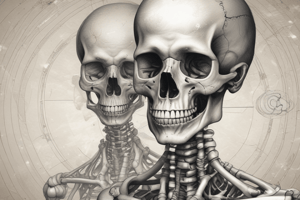Podcast
Questions and Answers
What is the second most common kidney anomaly?
What is the second most common kidney anomaly?
- Ectopic ureter
- Multicystic dysplastic kidney (MCDK) (correct)
- Horseshoe kidney
- Unilateral renal agenesis
How does the ultrasound appearance of multicystic dysplastic kidney (MCDK) differ from other kidney anomalies?
How does the ultrasound appearance of multicystic dysplastic kidney (MCDK) differ from other kidney anomalies?
- It shows thickened renal parenchyma
- It shows cysts that do not connect to the renal pelvis (correct)
- It shows normal kidney structure with scattered cysts
- It shows a functioning kidney with cysts
What is the main difference between multicystic dysplastic kidney (MCDK) and polycystic kidney disease?
What is the main difference between multicystic dysplastic kidney (MCDK) and polycystic kidney disease?
- MCDK is always bilateral, while polycystic kidney disease can be unilateral
- MCDK is nonfunctional due to loss of function over time, while polycystic kidney disease is functional (correct)
- Absence of cysts in MCDK but presence in polycystic kidney disease
- Presence of nephrons in MCDK but not in polycystic kidney disease
What is the characteristic feature of ureteropelvic junction obstruction (UPJO)?
What is the characteristic feature of ureteropelvic junction obstruction (UPJO)?
What is the most common anomaly associated with vesicoureteral reflux (VUR)?
What is the most common anomaly associated with vesicoureteral reflux (VUR)?
What is the main purpose of using DMSA in the context of kidney conditions?
What is the main purpose of using DMSA in the context of kidney conditions?
How does unilateral renal agenesis impact the remaining kidney?
How does unilateral renal agenesis impact the remaining kidney?
What is the distinguishing feature of Multicystic Dysplastic Kidney (MCDK) in comparison to UPJO (Ureteropelvic Junction Obstruction) on ultrasound?
What is the distinguishing feature of Multicystic Dysplastic Kidney (MCDK) in comparison to UPJO (Ureteropelvic Junction Obstruction) on ultrasound?
What is the management approach for Supernumerary Kidney when it is asymptomatic?
What is the management approach for Supernumerary Kidney when it is asymptomatic?
What is the most significant consequence of bilateral renal agenesis during fetal development?
What is the most significant consequence of bilateral renal agenesis during fetal development?




